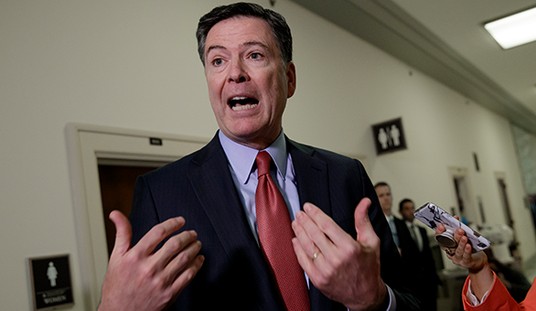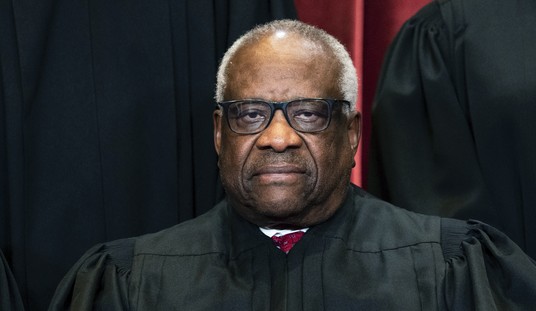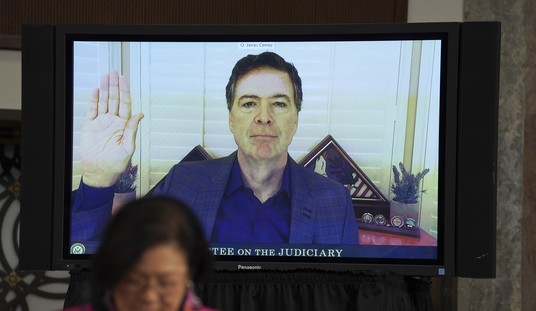[youtube FxKtZmQgxrI]
Everybody else has already linked to the viral epic YouTube deconstruction of the Episode One of the Star Wars series already, but just in case you missed it, run, don’t walk, to this hyperlink.
It’s 32 flavors of awesome — sort of Siskel and Ebert meets Charles Manson; a brilliant analysis of why a horribly written film fails dramatically (which should be required viewing for every film student in America), intermingled with a goofy subplot out of Silence of the Lambs. (And yes, the language is R-rated, with plenty of F-bombs.)
The first six segments analyze all of the film’s woes, including incomprehensible dialogue, illogical plotting, characters who have no traits we can identify with, and special effects for their own sake that don’t help to advance the story. The first segment builds on something that Jonathan Last described a few years ago:
It is now safe to declare the Star Wars prequels a failure. Whatever their merits as films, the three panels of George Lucas’s new triptych, The Phantom Menace, Attack of the Clones, and The Revenge of the Sith have failed to add permanently to the Star Wars mythology. Try to name one character or image or line of dialogue from these prequels that will, 30 years from now, have the cultural resonance that Darth Vader, the Death Star, the Millennium Falcon, the Mos Eisley creature cantina, “Use the Force,” or “Luke, I am your father” have today.The only iconic figure to emerge from the prequels is Darth Maul, the horned, red-faced Sith who had barely any dialogue and was dead by the end of Phantom Menace. But at least we’ll remember him. Next to Darth Maul, the image most likely to endure from the prequels is Jar-Jar Binks, who is regarded as a campy mistake, like the ewoks from Return of the Jedi. The rest of these three movies–some seven hours of story-telling–has turned out to be merely disposable cinematic product, like Tomb Raider or Planet of the Apes.
You can judge the size of the prequels’ cultural footprint by studying the merchandising. For instance, when Cingular began hawking its Star Wars tie-ins recently, they used characters from the original Star Wars movies–Chewbacca, Vader, Storm Troopers–not characters from Revenge of the Sith. The Star Wars toy industry has likewise become a shell of its former self: Where toy stores had permanent aisles devoted to an ever-growing collection of Star Wars vehicles, action figures, and paraphernalia from the late 1970s throughout the 1980s, toys tied to the prequels are now seasonal items–they blossom every three years when a movie comes out, and then quickly recede.
But let’s flesh-out the logical explanation for the prequels’ woes proffered in the YouTube series’ last segment. In the 1970s, Lucas had only directed two features before Star Wars, and only one of those (American Graffiti) was a hit, and was spending time with an awesome coterie of fellow movie brats, including Francis Ford Coppola, Steven Spielberg, Brian De Palma, and even, back when Hollywood still allowed such a rare beast, a token conservative, John Milius. They provided crucial input on the first drafts of the Star Wars scripts, which were just about as incomprehensible, in their dialogue, their characters and their motivation, and their plotting, as The Phantom Menace. Plus Lucas had to convince a skeptical 20th Century Fox why they should part with 10 million dollars — a fair chunk of money for a movie in the mid-1970s.
Flash-forward to the mid-1990s. Lucas is a zillionaire, who could either self-fund his movies, or get on the phone with 20th Century Fox and almost instantly be handed a blank check and final cut for a film that’s as bankable as any ever made. There’s nobody on his staff to say no, or to argue that the emperor’s script has no warp power.
Additionally, the Star Wars films, much like the original Star Trek series, work as much by what’s left out by what’s on the screen. As awesome as the original Star Wars of 1977 was, you know it’s taking place in a backwater of its onscreen universe, and are curious about what’s going on at the center of power. In the original Star Trek, it’s a given that the Enterprise is operating in deep space. We never see the wonders of the civilization that sent it out on its mission, other than the occasional “Starbase” — basically a matte painting of a handful of Mies van der Rohe office buildings on an exotic planet. (Similarly, in 2001: A Space Odyssey, once “Moonwatcher” heaves his bone metaphorically into space, we never see 21st century planet Earth except for occasional glimpses on TV monitors, forcing us to use our imagination as to how it evolved.)
By the time of the Star Wars prequels, Lucas had the special effects to do anything, but he bludgeons the audience with them — as the above YouTube clips note, overwhelmed by cross-cutting between four equally incomprehensible subplots, you’re left feeling exhausted and confused, rather than awestruck. And Lucas is essentially attempting to try to make an I, Claudius or Chinatown of outer space, and there’s nobody around whom the audience can identify with to help decipher all of the political intrigue, or, in the case of the latter film, identify with along the same lines as Nicholson’s private dick, even if we can’t make sense of the convoluted plotting.
In contrast, yes, this YouTube series is 70 minutes total, but watch the first clip, and see if you aren’t totally hooked by how well written and conceived this whole effort is. Which itself is a reminder that good writing is ultimately infinitely more important than production design and effects.
But as Big Hollywood also asks, will we see a sequel in a decade or so?










Join the conversation as a VIP Member